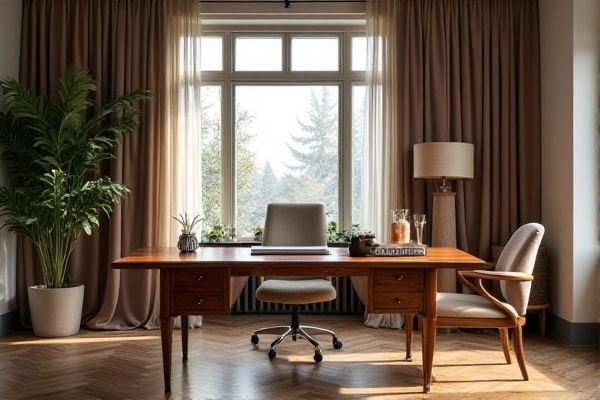
A drop-front desk features a hinged front panel that folds down to create a writing surface, offering storage when closed, while a writing desk typically has a fixed surface designed solely for writing or computer work. Understanding the distinctions can help you choose the perfect piece to enhance Your workspace--explore the rest of the article to find out which desk suits your needs best.
Table of Comparison
| Feature | Drop-Front Desk | Writing Desk |
|---|---|---|
| Design | Fold-down front panel that conceals workspace and storage | Simple flat surface with minimal or no storage compartments |
| Functionality | Multi-purpose: workspace plus hidden storage for documents and supplies | Primarily a writing surface with limited storage options |
| Space-saving | Compact when closed, ideal for small rooms or tight spaces | Requires permanent workspace with open design |
| Storage | Includes cubbies, drawers, or shelves inside drop-front panel | Minimal storage, often limited to a single drawer |
| Usage | Suitable for both writing and organizing paperwork or electronics | Best for straightforward writing or laptop use |
| Aesthetic | Traditional or vintage vibe due to enclosed design | Modern, minimalist, or classic depending on style |
| Price Range | Typically higher due to complex build and storage features | Generally more affordable and simpler in construction |
Introduction to Drop-Front Desks and Writing Desks
Drop-front desks feature a hinged panel that folds down to create a writing surface and conceal storage compartments, perfect for compact spaces. Writing desks typically offer a flat, open surface designed specifically for writing or computer work with minimal storage options. Your choice depends on whether you prioritize hidden storage and multifunctionality or a straightforward, accessible workspace.
Key Design Differences
A drop-front desk features a hinged front panel that folds down to create a writing surface, often revealing compartments and drawers for organized storage. Writing desks typically have a fixed, open tabletop designed solely for writing or working, prioritizing simplicity and ease of access. Your choice depends on whether you prefer multifunctional storage or a minimalist workspace.
Functionality and Use Cases
Drop-front desks offer concealed storage and a fold-down writing surface ideal for compact spaces or multi-purpose rooms, providing a tidy workspace that easily hides clutter. Writing desks typically have an open, flat surface suited for steady, extended work such as writing or computer use, often featuring minimal storage to maintain a clean and organized environment. Your choice depends on whether you prioritize space-saving flexibility and storage or a straightforward, dedicated writing area.
Space Efficiency Comparison
Drop-front desks maximize space efficiency by offering a fold-down writing surface that conceals clutter, ideal for small rooms or multifunctional areas. Writing desks typically have an open design with a fixed surface, providing more immediate workspace but requiring more room. Your choice depends on balancing the need for compact storage with accessible work area functionality.
Storage Capabilities and Organization
Drop-front desks offer versatile storage with multiple hidden compartments, cubbies, and small drawers behind the fold-down panel, ideal for organizing documents and stationery within a compact space. Writing desks typically feature open surfaces and minimal storage, often limited to a few drawers or shelves, prioritizing workspace over extensive organization options. The drop-front design enhances secure, clutter-free storage, while writing desks emphasize accessibility and simplicity for quick note-taking or laptop use.
Style and Aesthetic Appeal
Drop-front desks showcase a classic, elegant style with their concealed workspace and vintage charm, often featuring intricate woodwork and traditional design elements. Writing desks offer a more minimalist and versatile aesthetic, focusing on clean lines and open surfaces that complement modern or contemporary interiors. Your choice depends on whether you prefer the timeless sophistication of a drop-front desk or the streamlined simplicity of a writing desk.
Durability and Material Choices
Drop-front desks often feature sturdy hardwood construction such as oak or mahogany, providing enhanced durability and resistance to wear compared to many writing desks made from lighter materials like pine or MDF. The hinged front panel of drop-front desks requires reinforced hardware and solid joints to withstand repeated use, making material quality crucial for longevity. Writing desks tend to offer a wider variety of materials including veneer and laminate finishes, which may sacrifice some durability in favor of design versatility.
Price Range and Investment Value
Drop-front desks often have a higher price range due to their intricate craftsmanship and multifunctional design, making them a valuable investment for collectors and those seeking timeless furniture. Writing desks typically come at a more affordable price point, providing practical functionality without the premium cost associated with antique or elaborate pieces. Your choice depends on whether you prioritize long-term investment value or immediate budget-friendly utility.
Ideal Environments for Each Desk Type
Drop-front desks are ideal for small spaces such as apartments or home offices where space-saving functionality and concealed storage are essential, making them perfect for focused work and organization. Writing desks suit open, airy environments like living rooms or studios, providing a minimalist surface for writing or light tasks without bulky storage features. Both desk types enhance productivity but cater to different spatial and organizational needs, with drop-front desks emphasizing compact utility and writing desks promoting simplicity and openness.
Which Desk Should You Choose?
A drop-front desk offers a compact workspace with a fold-down surface that doubles as a cover to keep your materials organized and concealed, making it ideal for small spaces or multifunctional rooms. A writing desk provides a permanent, open work surface often accompanied by drawers or shelves for easily accessible storage, suited for those requiring consistent and spacious setups. Your choice depends on whether you prioritize space-saving versatility or a stable, accessible area for extended writing or computer tasks.
 homyna.com
homyna.com